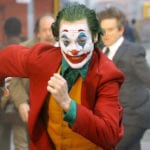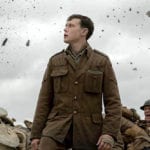 Miscellaneous
Miscellaneous  Miscellaneous
Miscellaneous  Gaming
Gaming 10 Funny Tutorials in Games
 History
History 10 Fascinating Little-Known Events in Mexican History
 Facts
Facts 10 Things You May Not Know about the Statue of Liberty
 Movies and TV
Movies and TV 10 Movie Adaptions That Brought Popular Songs to Life
 Health
Health 10 Miraculous Advances Toward Curing Incurable Diseases
 Miscellaneous
Miscellaneous 10 Undeniable Signs That People’s Views of Mushrooms Are Changing
 Animals
Animals 10 Strange Attempts to Smuggle Animals
 Travel
Travel 10 Natural Rock Formations That Will Make You Do a Double Take
 Movies and TV
Movies and TV 10 Actors Hidden in Your Favorite Movies
 Miscellaneous
Miscellaneous 10 Interesting Things Manufacturers Stopped Making and Why
 Gaming
Gaming 10 Funny Tutorials in Games
 History
History 10 Fascinating Little-Known Events in Mexican History
Who's Behind Listverse?

Jamie Frater
Head Editor
Jamie founded Listverse due to an insatiable desire to share fascinating, obscure, and bizarre facts. He has been a guest speaker on numerous national radio and television stations and is a five time published author.
More About Us Facts
Facts 10 Things You May Not Know about the Statue of Liberty
 Movies and TV
Movies and TV 10 Movie Adaptions That Brought Popular Songs to Life
 Health
Health 10 Miraculous Advances Toward Curing Incurable Diseases
 Miscellaneous
Miscellaneous 10 Undeniable Signs That People’s Views of Mushrooms Are Changing
 Animals
Animals 10 Strange Attempts to Smuggle Animals
 Travel
Travel 10 Natural Rock Formations That Will Make You Do a Double Take
 Movies and TV
Movies and TV 10 Actors Hidden in Your Favorite Movies
Top 10 Things That Can Go Wrong When Shooting A Movie
Filmmaking is hard. Hundreds of complex elements must come together smoothly to create an experience for the audience that lasts only a couple of hours. So it’s not surprising that things occasionally go wrong.
The more ambitious the project, the more likely that errors will occur. Sometimes, great movies are made despite the risks. Other times, these films bomb. Here, we look at 10 movies that didn’t go quite as planned.
10 Horrific Things That Happened During Movie Filming
10 When The River No Longer Runs Through It
William Friedkin had an enviable reputation when he signed on to direct the 1977 movie Sorcerer. Perhaps his massive successes with The French Connection and The Exorcist explain why the film studio acquiesced when he decided that Sorcerer needed a huge bridge built over a raging river in the Dominican Republic.
Unfortunately, by the time they were ready to shoot the bridge scene, the river had dried up. Not content to paint in the water, Friedkin moved the entire shoot to Mexico, where he rebuilt the bridge over another raging river.
1976 must have been a good summer because this river also ran dry before shooting began. Whether he would have continued building and dismantling bridges is unclear, but the studio put its foot down and Friedkin was obliged to accept some help from the effects department.
Nevertheless, the scene was stunning. The bridge looked rickety, with steel cables hidden inside frayed ropes. Hidden hydraulic systems made the bridge sway when vehicles crossed it. The little bit of water left in the river was sucked out by pumps into a set of sprinklers which provided the lashing rain.[1]
Later, Friedkin admitted that the filmmakers had lost five trucks over the side of bridge—sometimes with the driver still inside.
9 Storms, A Heart Attack, And Marlon Brando
When your movie has the word “apocalypse” in the title, you probably should expect trouble.
However, Francis Ford Coppola could not have known just how bad Apocalypse Now was going to get. This was probably just as well because he had invested $30 million of his own money in the film.
The movie was filmed in the Philippines. Although the shoot was supposed to last five months, it took over a year—and an eventful year it was. Storms wrecked the set, Martin Sheen had a heart attack, and according to Coppola, everyone went a little bit insane. Sheen drank too much, Dennis Hopper took too much cocaine, and Coppola had an epileptic fit.
Then Marlon Brando showed up.
He was massively overweight and underprepared. Production shut down for a week so that Coppola could go over Brando’s lines with him. Then Brando shaved his head and decided that he only wanted to be filmed in shadow.
Knowing that he faced financial ruin if the film bombed, Coppola had a nervous breakdown and contemplated suicide.[2]
Despite some major setbacks, the film was finished and is regarded as a masterpiece today.
8 When You Have The Wrong Sort Of Cloud
Some films are labors of love that the directors want to get just right. Which is admirable. However, moviemaking budgets usually can’t withstand such attention to detail. Film crews can be large, and location shoots are very expensive.
Most movies are a compromise between the artistic vision of the director and the financial constraints placed upon him. But some directors are not comfortable with limitations.
Take Michael Cimino, for instance. While he was directing Heaven’s Gate, the shoot constantly fell behind schedule due to his desire to get everything just right. For example, he wanted his sets to be historically accurate. If they weren’t, he tore them down and had them rebuilt.
That’s expensive.
He did so many takes that he used about 0.4 million meters (1.3 million ft) of film, which is also costly. However, there was little the studio could do because Cimino’s contract gave him absolute artistic freedom. He used it to get seemingly unimportant details just right.
For example, Kris Kristofferson had to crack a whip at least 50 times before Cimino was happy with the noise it made. An irrigation system was also installed to make the grass on his battlefield the right shade of green.
But things really got weird when shooting was halted for hours—and the cast, crew, and extras did nothing—while Cimino waited for just the right sort of cloud to float into the shot.[3]
When the shoot was finally over, Cimino changed the locks on his editing room door and began to work through the miles of footage. He was so pleased with his movie that the work print was 5.5 hours long. The studio demanded something shorter. The final film, a modest 3.5-hour epic, was released in 1980.
It bombed.
7 When The Shoot Is As Ugly As The Film
John Boorman’s 1972 movie Deliverance is not a pretty film. The story of four businessmen who take a trip into the wilderness, only to find it much more savage than they had expected, makes for uncomfortable viewing. As they battle to survive, their baser instincts take over.
And it is ugly.
The process of making the film was also nasty. Boorman wanted his actors to perform all their own stunts on their canoe trip down swollen rivers with fast-flowing currents. Burt Reynolds later claimed that Boorman had insisted the film be shot in sequence so that he could rewrite the script if one of the actors died.[4]
Which was a distinct possibility.
Jon Voight did a rock-climbing scene without a harness or any wires because the director wanted the scene shot in close-up. Reynolds broke his tailbone going over a waterfall in a canoe.
This is probably why all the characters in the film look so darned miserable. However, nobody died, and the movie was a critical success. Boorman got an Academy Award nomination for Best Director, and Deliverance was nominated for Best Picture.
6 When You Endanger The Stars
As a rule, Hollywood is protective of its stars. They are given their own trailers, dressers, and personal assistants. Someone does their hair and makeup, and another person fetches their coffee just the way they like it. But when the cameras roll, certain actors find themselves doing things that are decidedly less glamorous and sometimes downright dangerous.
Take Brendan Fraser, for example. He was almost hanged when the safety device on his noose failed to work in The Mummy. Isla Fisher almost drowned in a tank of water in Now You See Me. Margaret Hamilton was set on fire in her first scene in The Wizard of Oz. Her Wicked Witch of the West disappeared in a puff of red smoke, but the trapdoor beneath her feet failed to open.[5]
However, these actors survived.
The deaths of Vic Morrow and two child actors in a helicopter crash while filming Twilight Zone: The Movie led to one of the most prolonged lawsuits in movie history. In a stunningly tactless moment, director John Landis said of the accident, “There was absolutely no good aspect about this whole story. The tragedy, which I think about every day, had an enormous impact on my career, from which it may possibly never recover.”
The careers of Vic Morrow and those child actors ain’t doing so well, either.
Top 10 Tragic Movie Set Deaths
5 When You Annoy The Neighbors
When movies are shot on location, it can be annoying for residents who live and work in that area. Although production companies may make a lot of promises to residents before shooting begins, filmmakers don’t always keep them.
However, location scouts would do well to keep in mind what happened during the shoot of the original Doctor Dolittle movie in 1967. The film company had taken over an entire village in Wiltshire, England, and even built an enormous artificial dam.
The villagers were not pleased. One of them was an SAS officer named Ranulph Fiennes. He tried (but failed) to blow up the dam with some explosives that he had borrowed from his employers. Fiennes was dismissed from the army and had to find alternative employment as the world’s greatest living adventurer.[6]
Even so, Doctor Dolittle went massively over budget due to weather delays, animal problems, and casting issues. Worst of all, the film didn’t come close to covering its costs at the box office.
4 When You Are A Little Too True To Life
Realism in the movies is always good, and it’s nice when filmmakers go the extra mile to give audiences an authentic experience. Sometimes, though, they can take it a little too far.
Noel Marshall’s movie Roar is a case in point. The 1981 film depicts a man living with lions, tigers, and other dangerous animals in his own African wildlife sanctuary and what happens when his family comes for a visit.
Marshall hired his wife, Tippi Hedren, and his stepdaughter, Melanie Griffith, to star in the movie with him. It took 11 years to complete the film, probably due to the time that injured cast and crew members spent in the hospital from animal attacks.
Hedren had her head bitten by a lion, and Griffith was so badly injured that she needed 50 stitches on her face. Even worse, the cinematographer had his scalp torn off by a lion and needed over 200 stitches.[7]
After all that effort, Roar was finally released in 1981. It bombed.
3 When Your Location Is A Little Too Remote
What do you do if your movie is set in a unique yet somewhat remote historic location?
You could use the expertise of Hollywood set designers to recreate the environment within the safe confines of a soundstage. Or you could pack your bags and do the thing properly.
In the early 1990s, Kevin Reynolds decided that he had to travel to Easter Island to make Rapa Nui. Situated in a remote part of the Pacific Ocean, Easter Island was hard to access. It was even more difficult to bring in supplies to feed the crew.
The film supposedly explored the history of Easter Island and put forward theories about what had happened to the population. It seems, however, that Rapa Nui concentrated most of its authenticity on the location.[8]
Historians took issue with the movie over the accuracy of historical details. Meanwhile, film critics complained about the quality of the script. One reviewer said it was more Fantasy Island than Easter Island.
When Rapa Nui was released in 1994, it bombed.
2 When It Rains In The Desert
There are some things that you should be able to take for granted. Deserts are surely one of them.
However, George Miller discovered that this is not always so. While filming Mad Max: Fury Road, Miller eschewed CGI sequences, instead opting to race real vehicles in the actual desert of Namibia and crash those vehicles repeatedly.
This low-tech decision did not please everyone, particularly the producers who were footing the bill. However, the stunts certainly made for an entertaining film.
Namibia was not Miller’s first choice of location. As originally planned, the shoot was to take place in Australia. But an unexpectedly large amount of rainfall turned his dystopian desert into a lush oasis of flowers.[9]
Mad Max: Flora Road didn’t sound quite as cool, so the shoot had to cross continents before it could be completed. However, Miller’s determination was rewarded with 10 Academy Award nominations, including Best Director and Best Picture of 2015.
1 When Ships Just Won’t Sail—On Land
Werner Herzog is a man who thinks big. Not only is he a notable film director but he also writes, acts, and directs opera. His films are known for characters who are not afraid to follow their dreams, even when those aspirations are a little bit mad.
When Herzog made the film Fitzcarraldo in 1982, he took a leaf out of his protagonist’s book and pushed a massive steamboat over a mountain. The film features a man who wants to build an opera house in the Amazon jungle. He also decides that he can take a shortcut through the jungle if he drags his boat from the river, up a mountain, and down the other side to a different river.
Herzog didn’t want to rely on camera trickery, models, or any other cinematic techniques that would have made the job easier. He chose to use only the ropes and pulleys that you see in the movie, a bulldozer to clear the path, and a lot of indigenous extras. They actually pulled that 320-ton boat up the hill.[10]
The ropes hid steel cables, which became very hot and had to be cooled with buckets of water before the surrounding rope caught fire or the cable snapped. Every time the boat moved 9 meters (30 ft), the shoot halted while the cameras were reset. Huge logs were placed beneath the boat to prevent it from plowing into the soil. This was also shown in the film, so it had to be done by hand rather than by a crane.
Herzog was determined to have audiences see the whole ship moving and refused to cheapen the film with close-ups to cover up the hard bits. It took two weeks to get the ship to the top of the mountain.
Then they had to take a break for six months because the water in the river on the other side had all but dried up. They left the boat balanced at the top until the river swelled again. After six months out of water and the toll of the arduous journey, the boat almost capsized as it entered the water.
Although shooting that scene was completely nuts, it has become one of the most iconic in cinema history.
10 Notorious Film Sets That Injured, Maimed And Killed
About The Author: Ward Hazell is a freelance writer and travel writer who is currently studying for a PhD in English literature.








